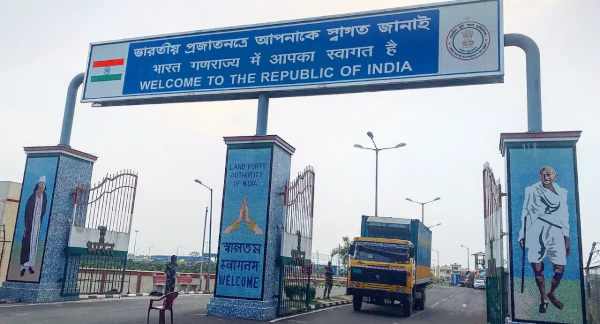India will have 24 Integrated Check Posts (ICPs) along its land borders by 2025, said Aditya Mishra, Chairman, Land Ports Authority of India (LPAI) in what could enable better integration of the region and beyond to SE Asia.
The ICPs are entry and exit points on India’s land borders and house various facilities such as customs, immigration, and border security, quarantine, among others, within a single facilitation zone.
“We have 24 land ports that the government has already approved, about 9 are already functional, some are under construction and some are under various stages of development. Hopefully in the next two years, the number should increase to at least 20,” said Mishra at a seminar organised by leading think tank Centre for Social and Economic Progress (CSEP) on Wednesday.
In addition to the ICPs, there are plans to ensure that all 90 transit points along the15,000 km border are covered under standard infrastructure. “This will be there to facilitate all types of trade, transit and travel,” he added. Mishra was speaking at the launch of a new paper, Linking Land Borders: India’s Integrated Check Posts, by Riya Sinha, Research Associate at CSEP, that combines new data, fieldwork and interviews to offer a deep dive analysis of India’s ICPs, their formation, and their role in facilitating connectivity in South Asia.
The panel featured Rakesh Mohan, President, CSEP, and former deputy governor, RBI, Vikram Doraiswami, High Commissioner of India to Bangladesh; Nisha Taneja, Professor, Indian Council for Research on International Economic Relations (ICRIER); Pritam Banerjee, Logistics Sector Specialist Consultant, Asian Development Bank (ADB); Riya Sinha, Research Associate, CSEP; moderated by Constantino Xavier, Fellow, CSEP.
The Government of India has been allocating funds for the establishment of ICPs. In January 2021, the central government released Rs 90 crores for the ICP at Sabroom, Tripura. “This increased momentum on ICPs is driven by several factors, including rising trade between India and the neighbouring countries, the demand from smaller South Asian countries to increase connectivity infrastructure. China is also an important player because of its growing investments in the region after 2005. Finally, India’s international obligations also drive this approach to strengthen infrastructure at the border,” said Sinha.
The conversation focused on India’s push towards regional connectivity and how ICPs could further that goal. Mohan noted that South Asia as a region had long suffered from poor connectivity. “Next year will be the 75th anniversary of our independence and the partition…the country needs to be far more ambitious in integrating the region,” he said.
“A very important part of what land ports do is move people,” said Doraiswami. He pointed out that India’s biggest visa operations in the world was with Bangladesh. “In the pre-Covid era, we issued 1.8 million visas. 2.8 million Bangladeshis travelled to India and 2.5 million of them used the land route,” he added.
According to Doraiswami, regional connectivity infrastructure in South Asia needed a “360 vision”. “What is necessary, I think, is a greater sense of business integration into this – not just traders but people who actually move – railways, bus services, and transporters as part of the ecosystem,” he said.
India’s first ICP was inaugurated in 2012, as part of a move to modernise border management infrastructure to facilitate trade and passenger movement. In 2019-20, 40% of India’s total land-based trade with Bangladesh, Nepal, Myanmar, and Pakistan took place through the six inaugurated ICPs at Agartala, Petrapole, Raxaul, Jogbani, Moreh and Attari.
Taneja said that India’s new focus on the Act East policy and the Indo-Pacific should serve as an added impetus to prepare a strategy for infrastructure development. “To pursue Act East policy, (India) could take the lead to also encourage Bangladesh, Bhutan and Myanmar to join the TIR (Transports Internationaux Routiers or International Road Transports) Convention,” Taneja added.
“The Act East policy is mostly about maritime trade with Southeast Asia, and land trade with Myanmar remains minimal, so ICPs should focus on the BBIN (Bangladesh-Bhutan-India-Nepal) region, especially on facilitating connectivity with Bangladesh, India’s major trade partner in South Asia,” said Pritam Banerjee. Connectivity with India’s Northeast via Bangladesh is also a priority. “One of the efforts, which will very soon show on ground, is the corridor in southern Tripura through Sabroom, which will connect Chittagong port with the rest of the Northeast,” said Mishra.
“Beyond all the geostrategic drama, the politics, security playing out in this region, there is finally a momentum to focus on infrastructure connectivity to bridge the gaps that have kept countries apart in and around the subcontinent,” said Xavier, who leads the Sambandh Regional Connectivity Initiative at CSEP.
Another significant aspect of land borders is to balance security concerns with economic benefits. Banerjee argued that a focus on security concerns wasn’t unique to South Asia, but it was time to have a much greater focus on sequencing infrastructure investments. “We have some very critical corridors, and they are actually served by about 8-9 of our existing ICPs. They define 80-85% of trade…these 8-9 ICPs will define the geography of trade in this region as we go forward,” he said.
Doraiswami said that there was an immediate need to “diversify away from choke points”. “Many existing routes need to be extensively modernised to facilitate more trade from Nepal to Bangladesh, Bhutan to Bangladesh,” he added.
Doraiswami emphasised the importance of ‘following the money’ rather than having grand vision documents. “Because we are getting investments and there is huge demand for border haats and other facilities, there is momentum in connectivity initiatives. We just have to allow economic rationale to take the lead.”
Source: ET
You may also like
-
Trade Connect E-platform For Exports Is Single Window, Fast, Accessible And Transformational: Shri Piyush Goyal
-
Dot Simplifies Approval Processes For Telecom Licenses And Wireless Equipment
-
Coal Production and Supply Trends on Positive Trajectory
-
Union Minister To Release Booklets On Promotion Of Indigenous Species & Conservation Of States Fishes
-
2nd India-Japan Finance Dialogue held in Tokyo on 6th September, 2024
